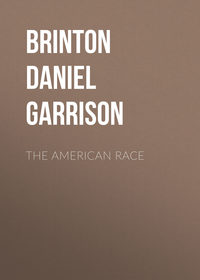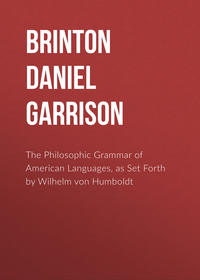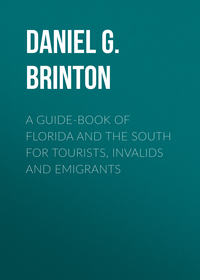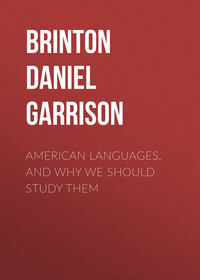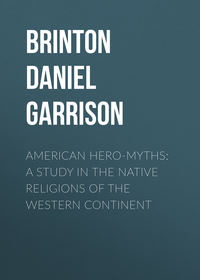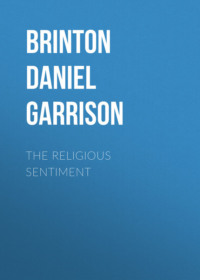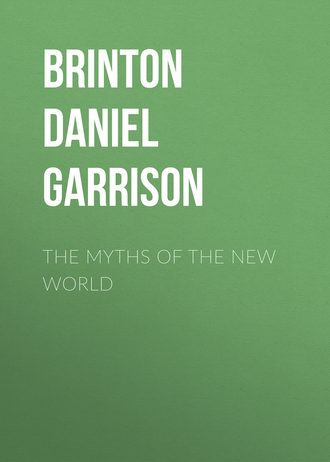 полная версия
полная версияThe Myths of the New World
There is no occasion to suppose deceit in this. It finds its parallel in every race and every age, and rests on a characteristic trait of certain epochs and certain men, which leads them to seek the divine, not in thoughtful contemplation on the laws of the universe and the facts of self-consciousness, but in an entire immolation of the latter, a sinking of their own individuality in that of the spirits whose alliance they seek. This is an outgrowth of that ignoring of the universality of Law, which belongs to the lower stages of enlightenment.419 And as this is never done with impunity, but with iron certainty brings its punishment with it, the study of the mental conditions thus evoked, and the results which follow them, offers a salutary subject of reflection to the theologian as well as the physician. For these examples of nervous pathology are identical in kind, and alike in consequences, whether witnessed in the primitive forests of the New World, among the convulsionists of St. Medard, or in the excited scenes of a religious revival in one of our own churches.
Sleeplessness and abstemiousness, carried to the utmost verge of human endurance—seclusion, and the pertinacious fixing of the mind on one subject—obstinate gloating on some morbid fancy, rarely failed to bring about hallucinations with all the garb of reality. Physicians are well aware that the more frequently these diseased conditions of the mind are sought, the more readily they are found. Then, again, they were often induced by intoxicating and narcotic herbs. Tobacco, the maguey, coca; in California the chucuaco; among the Mexicans the snake plant, ollinhiqui or coaxihuitl; and among the southern tribes of our own country the cassine yupon and iris versicolor,420 were used; and, it is even said, were cultivated for this purpose. The seer must work himself up to a prophetic fury, or speechless lie in apparent death before the mind of the gods would be opened to him. Trance and ecstasy were the two avenues he knew to divinity; fasting and seclusion the means employed to discover them. His ideal was of a prophet who dwelt far from men, without need of food, in constant communion with divinity. Such an one, in the legends of the Tupis, resided on a mountain glittering with gold and silver, near the river Uaupe, his only companion a dog, his only occupation dreaming of the gods. When, however, an eclipse was near, his dog would bark; and then, taking the form of a bird, he would fly over the villages, and learn the changes that had taken place.421
But man cannot trample with impunity on the laws of his physical life, and the consequences of these deprivations and morbid excitements of the brain show themselves in terrible pictures. Not unfrequently they were carried to the pitch of raving mania, reminding one of the worst forms of the Berserker fury of the Scandinavians, or the Bacchic rage of Greece. The enthusiast, maddened with the fancies of a disordered intellect, would start forth from his seclusion in an access of demoniac frenzy. Then woe to the dog, the child, the slave, or the woman who crossed his path; for nothing but blood could satisfy his inappeasable craving, and they fell instant victims to his madness. But were it a strong man, he bared his arm, and let the frenzied hermit bury his teeth in the quivering flesh. Such is a scene at this day not uncommon on the northwest coast, and few of the natives around Milbank Sound are without the scars the result of this horrid custom.422
This frenzy, terrible enough in individuals, had its most disastrous effects when with that peculiar facility of contagion which marks hysterical maladies, it swept through whole villages, transforming them into bedlams filled with unrestrained madmen. Those who have studied the strange and terrible mental epidemics that visited Europe in the middle ages, such as the tarantula dance of Apulia, the chorea Germanorum, and the great St. Vitus’ dance, will be prepared to appreciate the nature of a scene at a Huron village, described by Father le Jeune in 1639. A festival of three days and three nights had been in progress to relieve a woman who, from the description, seems to have been suffering from some obscure nervous complaint. Toward the close of this vigil, which throughout was marked by all sorts of debaucheries and excesses, all the participants seemed suddenly seized by ten thousand devils. They ran howling and shrieking through the town, breaking everything destructible in the cabins, killing dogs, beating the women and children, tearing their garments, and scattering the fires in every direction with bare hands and feet. Some of them dropped senseless, to remain long or permanently insane, but the others continued until worn out with exhaustion. The Father learned that during these orgies not unfrequently whole villages were consumed, and the total extirpation of some families had resulted. No wonder that he saw in them the diabolical workings of the prince of evil, but the physician is rather inclined to class them with those cases of epidemic hysteria, the common products of violent and ill-directed mental stimuli.423
These various considerations prove beyond a doubt that the power of the priesthood did by no means rest exclusively on deception. They indorse and explain the assertions of converted natives, that their power as prophets was something real, and entirely inexplicable to themselves. And they make it easily understood how those missionaries failed who attempted to persuade them that all this boasted power was false. More correct views than these ought to have been suggested by the facts themselves, for it is indisputable that these magicians did not hesitate at times to test their strength on each other. In these strange duels à l’outrance, one would be seated opposite his antagonist, surrounded with the mysterious emblems of his craft, and call upon his gods one after another to strike his enemy dead. Sometimes one, “gathering his medicine,” as it was termed, feeling within himself that hidden force of will which makes itself acknowledged even without words, would rise in his might, and in a loud and severe voice command his opponent to die! Straightway the latter would drop dead, or yielding in craven fear to a superior volition, forsake the implements of his art, and with an awful terror at his heart, creep to his lodge, refuse all nourishment, and presently perish. Still more terrible was the tyranny they exerted on the superstitious minds of the masses. Let an Indian once be possessed of the idea that he is bewitched, and he will probably reject all food, and sink under the phantoms of his own fancy.
How deep the superstitious veneration of these men has struck its roots in the soul of the Indian, it is difficult for civilized minds to conceive. Their power is currently supposed to be without any bounds, “extending to the raising of the dead and the control of all laws of nature.”424 The grave offers no escape from their omnipotent arms. The Sacs and Foxes, Algonkin tribes, think that the soul cannot leave the corpse until set free by the medicine men at their great annual feast;425 and the Puelches of Buenos Ayres guard a profound silence as they pass by the tomb of some redoubted necromancer, lest they should disturb his repose, and suffer from his malignant skill.426
While thus investigating their real and supposed power over the physical and mental world, their strictly priestly functions, as performers of the rites of religion, have not been touched upon. Among the ruder tribes these, indeed, were of the most rudimentary character. Sacrifices, chiefly in the form of feasts, where every one crammed to his utmost, dances, often winding up with the wildest scenes of licentiousness, the repetition of long and monotonous chants, the making of the new fire, these are the ceremonies that satisfy the religious wants of savages. The priest finds a further sphere for his activity in manufacturing and consecrating amulets to keep off ill luck, in interpreting dreams, and especially in lifting the veil of the future. In Peru, for example, they were divided into classes, who made the various means of divination specialties. Some caused the idols to speak, others derived their foreknowledge from words spoken by the dead, others predicted by leaves of tobacco or the grains and juice of cocoa, while to still other classes, the shapes of grains of maize taken at random, the appearance of animal excrement, the forms assumed by the smoke rising from burning victims, the entrails and viscera of animals, the course taken by a certain species of spider, the visions seen in drunkeness, the flights of birds, and the directions in which fruits would fall, all offered so many separate fields of prognostication, the professors of which were distinguished by different ranks and titles.427
As the intellectual force of the nation was chiefly centred in this class, they became the acknowledged depositaries of its sacred legends, the instructors in the art of preserving thought; and from their duty to regulate festivals, sprang the observation of the motions of the heavenly bodies, the adjustment of the calendars, and the pseudo-science of judicial astrology. The latter was carried to as subtle a pitch of refinement in Mexico as in the old world; and large portions of the ancient writers are taken up with explaining the method adopted by the native astrologers to cast the horoscope, and reckon the nativity of the newly-born infant.
How was this superior power obtained? What were the terms of admission to this privileged class? In the ruder communities the power was strictly personal. It was revealed to its possessor by the character of the visions he perceived at the ordeal he passed through on arriving at puberty; and by the northern nations was said to be the manifestation of a more potent personal spirit than ordinary. It was not a faculty, but an inspiration; not an inborn strength, but a spiritual gift. The curious theory of the Dakotas, as recorded by the Rev. Mr. Pond, was that the necromant first wakes to consciousness as a winged seed, wafted hither and thither by the intelligent action of the Four Winds. In this form he visits the homes of the different classes of divinities, and learns the chants, feasts, and dances, which it is proper for the human race to observe, the art of omnipresence or clairvoyance, the means of inflicting and healing diseases, and the occult secrets of nature, man, and divinity. This is called “dreaming of the gods.” When this instruction is completed, the seed enters one about to become a mother, assumes human form, and in due time manifests his powers. Four such incarnations await it, each of increasing might, and then the spirit returns to its original nothingness. The same necessity of death and resurrection was entertained by the Eskimos. To become of the highest order of priests, it was supposed requisite, says Bishop Egede, that one of the lower order should be drowned and eaten by sea monsters. Then, when his bones, one after another, were all washed ashore, his spirit, which meanwhile had been learning the secrets of the invisible world, would return to them, and, clothed in flesh, he would go back to his tribe. At other times a vague and indescribable longing seizes a young person, a morbid appetite possesses them, or they fall a prey to an inappeasable and aimless restlessness, or a causeless melancholy. These signs the old priests recognize as the expression of a personal spirit of the higher order. They take charge of the youth, and educate him to the mysteries of their craft. For months or years he is condemned to entire seclusion, receiving no visits but from the brethren of his order. At length he is initiated with ceremonies of more or less pomp into the brotherhood, and from that time assumes that gravity of demeanor, sententious style of expression, and general air of mystery and importance, everywhere deemed so eminently becoming in a doctor and a priest. A peculiarity of the Moxos was, that they thought none designated for the office but such as had escaped from the claws of the South American tiger, which, indeed, it is said they worshipped as a god.428
Occasionally, in very uncultivated tribes, some family or totem claimed a monopoly of the priesthood. Thus, among the Nez Percès of Oregon, it was transmitted in one family from father to son and daughter, but always with the proviso that the children at the proper age reported dreams of a satisfactory character.429 Perhaps alone of the Algonkin tribes the Shawnees confined it to one totem, but it is remarkable that the greatest of their prophets, Elskataway, brother of Tecumseh, was not a member of this clan. From the most remote times, the Cherokees have had one family set apart for the priestly office. This was when first known to the whites that of the Nicotani, but its members, puffed up with pride and insolence, abused their birthright so shamefully, and prostituted it so flagrantly to their own advantage, that with savage justice they were massacred to the last man. Another was appointed in their place who to this day officiates in all religious rites. They have, however, the superstition, possibly borrowed from Europeans, that the seventh son is a natural born prophet, with the gift of healing by touch.430 Adair states that their former neighbors, the Choctaws, permitted the office of high priest, or Great Beloved Man, to remain in one family, passing from father to eldest son, and the very influential piaches of the Carib tribes very generally transmitted their rank and position to their children.
In ancient Anahuac the prelacy was as systematic and its rules as well defined, as in the Church of Rome. Except those in the service of Huitzilopochtli, and perhaps a few other gods, none obtained the priestly office by right of descent, but were dedicated to it from early childhood. Their education was completed at the Calmecac, a sort of ecclesiastical college, where instruction was given in all the wisdom of the ancients, and the esoteric lore of their craft. The art of mixing colors and tracing designs, the ideographic writing and phonetic hieroglyphs, the songs and prayers used in public worship, the national traditions and the principles of astrology, the hidden meaning of symbols and the use of musical instruments, all formed parts of the really extensive course of instruction they there received. When they manifested a satisfactory acquaintance with this curriculum, they were appointed by their superiors to such positions as their natural talents and the use they had made of them qualified them for, some to instruct children, others to the service of the temples, and others again to take charge of what we may call country parishes. Implicit subordination of all to the high priest of Huitzilopochtli, hereditary pontifex maximus, chastity, or at least temperate indulgence in pleasure, gravity of carriage, and strict attention to duty, were laws laid upon all.
The state religion of Peru was conducted under the supervision of a high priest of the Inca family, and its ministers, as in Mexico, could be of either sex, and hold office either by inheritance, education, or election. For political reasons, the most important posts were usually enjoyed by relatives of the ruler, but this was usage, not law. It is stated by Garcilasso de la Vega431 that they served in the temples by turns, each being on duty the fourth of a lunar month at a time. Were this substantiated it would offer the only example of the regulation of public life by a week of seven days to be found in the New World.
In every country there is perceptible a desire in this class of men to surround themselves with mystery, and to concentrate and increase their power by forming an intimate alliance among themselves. They affected singularity in dress and a professional costume. Bartram describes the junior priests of the Creeks as dressed in white robes and carrying on their head or arm “a great owlskin, stuffed very ingeniously, as an insignia of wisdom and divination. These bachelors are also distinguishable from the other people by their taciturnity, grave and solemn countenance, dignified step, and singing to themselves songs or hymns, in a low sweet voice, as they stroll about the towns.”432 The priests of the civilized nations adopted various modes of dress to typify the divinity which they served, and their appearance was often in the highest degree unprepossessing.
To add to their self-importance they pretended to converse in a tongue different from that used in ordinary life, and the chants containing the prayers and legends were often in this esoteric dialect. Fragments of one or two of these have floated down to us from the Aztec priesthood. The travellers Balboa and Coreal, mention that the temple services of Peru were conducted in a language not understood by the masses,433 and the incantations of the priests of Powhatan were not in ordinary Algonkin, but some obscure jargon.434 The same peculiarity has been observed among the Dakotas and Eskimos, and in these nations, fortunately, it fell under the notice of competent linguistic scholars, who have submitted it to a searching examination. The results of their labors prove that certainly in these two instances the supposed foreign tongues were nothing more than the ordinary dialects of the country modified by an affected accentuation, by the introduction of a few cabalistic terms, and by the use of descriptive circumlocutions and figurative words in place of ordinary expressions, a slang, in short, such as rascals and pedants invariably coin whenever they associate.435
All these stratagems were intended to shroud with impenetrable secrecy the mysteries of the brotherhood. With the same motive, the priests formed societies of different grades of illumination, only to be entered by those willing to undergo trying ordeals, whose secrets were not to be revealed under the severest penalties. The Algonkins had three such grades, the waubeno, the meda, and the jossakeed, the last being the highest. To this no white man was ever admitted. All tribes appear to have been controlled by these secret societies. Alexander von Humboldt mentions one, called that of the Botuto or Holy Trumpet, among the Indians of the Orinoko, whose members must vow celibacy and submit to severe scourgings and fasts. The Collahuayas of Peru were a guild of itinerant quacks and magicians, who never remained permanently in one spot.
Withal, there was no class of persons who so widely and deeply influenced the culture and shaped the destiny of the Indian tribes, as their priests. In attempting to gain a true conception of the race’s capacities and history, there is no one element of their social life which demands closer attention than the power of these teachers. Hitherto, they have been spoken of with a contempt which I hope this chapter shows is unjustifiable. However much we may deplore the use they made of their skill, we must estimate it fairly, and grant it its due weight in measuring the influence of the religious sentiment on the history of man.
CHAPTER XI.
THE INFLUENCE OF THE NATIVE RELIGIONS ON THE MORAL AND SOCIAL LIFE OF THE RACE
Natural religions hitherto considered of Evil rather than of Good.—Distinctions to be drawn.—Morality not derived from religion.—The positive side of natural religions in incarnations of divinity.—Examples.—Prayers as indices of religious progress.—Religion and social advancement.—Conclusion.
DRAWING toward the conclusion of my essay, I I am sensible that the vast field of American mythology remains for most part untouched—that I have but proved that it is not an absolute wilderness, pathless as the tropical jungles which now conceal the temples of the race; but that, go where we will, certain landmarks and guide-posts are visible, revealing uniformity of design and purpose, and refuting, by their presence, the oft-repeated charge of entire incoherence and aimlessness. It remains to examine the subjective power of the native religions, their influence on those who held them, and the place they deserve in the history of the race. What are their merits, if merits they have? what their demerits? Did they purify the life and enlighten the mind, or the contrary? Are they in short of evil or of good? The problem is complex—its solution most difficult. The author who of late years has studied most profoundly the savage races of the globe, expresses the discouraging conviction: “Their religions have not acted as levers to raise them to civilization; they have rather worked, and that powerfully, to impede every step in advance, in the first place by ascribing everything unintelligible in nature to spiritual agency, and then by making the fate of man dependent on mysterious and capricious forces, not on his own skill and foresight.”436
It would ill accord with the theory of mythology which I have all along maintained if this verdict were final. But in fact these false doctrines brought with them their own antidotes, at least to some extent, and while we give full weight to their evil, let us also acknowledge their good. By substituting direct divine interference for law, belief for knowledge, a dogma for a fact, the highest stimulus to mental endeavor was taken away. Nature, to the heathen, is no harmonious whole swayed by eternal principles, but a chaos of causeless effects, the meaningless play of capricious ghosts. He investigates not, because he doubts not. All events are to him miracles. Therefore his faith knows no bounds, and those who teach that doubt is sinful must contemplate him with admiration. The damsels of Nicaragua destined to be thrown into the seething craters of volcanoes, went to their fate, says Pascual de Andagoya, “happy as if they were going to be saved,”437 and doubtless believing so. The subjects of a Central American chieftain, remarks Oviedo, “look upon it as the crown of favors to be permitted to die with their cacique, and thus to acquire immortality.”438 The terrible power exerted by the priests rested, as they themselves often saw, largely on the implicit and literal acceptance of their dicta.
In some respects the contrast here offered to enlightened nations is not always in favor of the latter. Borrowing the pointed antithesis of the poet, the mind is often tempted to exclaim—
“This is allThe gain we reap from all the wisdom sownThrough ages: Nothing doubted those first sonsOf Time, while we, the schooled of centuries,Nothing believe.”But the complaint is unfounded. Faith is dearly bought at the cost of knowledge; nor in a better sense has it yet gone from among us. Far more sublime than any known to the barbarian is the faith of the astronomer, who spends the nights in marking the seemingly wayward motions of the stars, or of the anatomist, who studies with unwearied zeal the minute fibres of the organism, each upheld by the unshaken conviction that from least to greatest throughout this universe, purpose and order everywhere prevail.
Natural religions rarely offer more than this negative opposition to reason. They are tolerant to a degree. The savage, void of any clear conception of a supreme deity, sets up no claim that his is the only true church. If he is conquered in battle, he imagines that it is owing to the inferiority of his own gods to those of his victor, and he rarely therefore requires any other reasons to make him a convert. Acting on this principle, the Incas, when they overcame a strange province, sent its most venerated idol for a time to the temple of the Sun at Cuzco, thus proving its inferiority to their own divinity, but took no more violent steps to propagate their creeds.439 So in the city of Mexico there was a temple appropriated to the idols of conquered nations in which they were shut up, both to prove their weakness and prevent them from doing mischief. A nation, like an individual, was not inclined to patronize a deity who had manifested his incompetence by allowing his charge to be gradually worn away by constant disaster. As far as can now be seen, in matters intellectual, the religions of ancient Mexico and Peru were far more liberal than that introduced by the Spanish conquerors, which, claiming the monopoly of truth, sought to enforce its claim by inquisitions and censorships.
In this view of the relative powers of deities lay a potent corrective to the doctrine that the fate of man was dependent on the caprices of the gods. For no belief was more universal than that which assigned to each individual a guardian spirit. This invisible monitor was an ever present help in trouble. He suggested expedients, gave advice and warning in dreams, protected in danger, and stood ready to foil the machinations of enemies, divine or human. With unlimited faith in this protector, attributing to him the devices suggested by his own quick wits and the fortunate chances of life, the savage escaped the oppressive thought that he was the slave of demoniac forces, and dared the dangers of the forest and the war path without anxiety.




